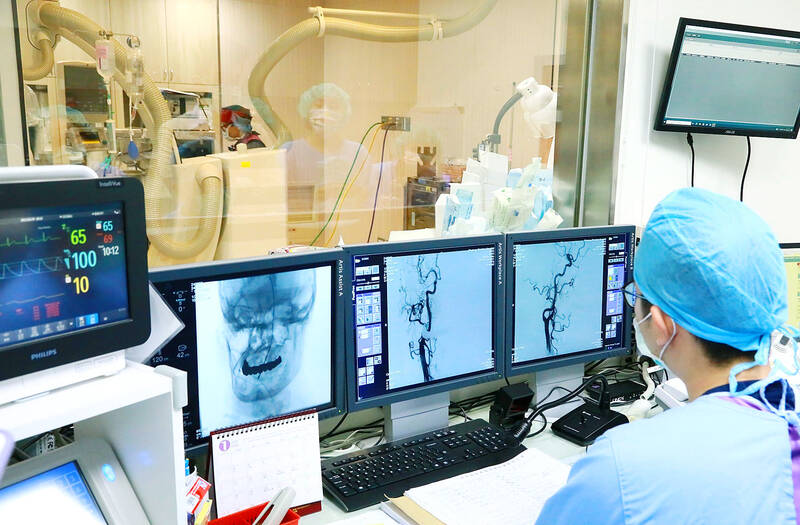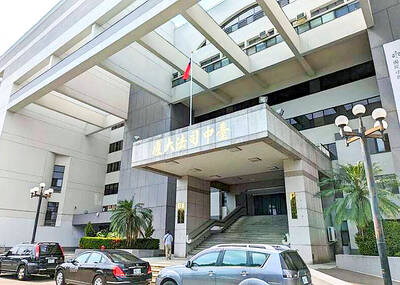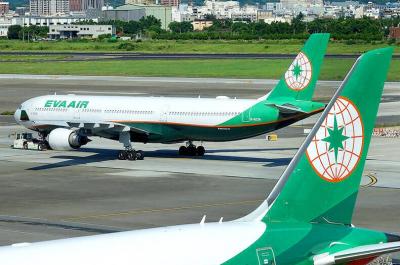The number of stroke cases in Taiwan has been growing in the past few years, exceeding 470,000 last year, with people aged 50 or younger accounting for about 10 percent and people aged 60 or younger accounting for about 25 percent, which shows that younger people are increasingly at risk.
National Health Insurance Administration data showed that 471,000 people were admitted to hospital with a stroke last year, up from 435,000 five years earlier, while the overall medical costs increased to NT$18.7 billion (US$610.3) from NT$16.9 billion.
Even though more men are affected, the number of women who had a stroke rose to nearly 210,000 last year, or about 44.5 percent of all cases, the data showed.

Photo courtesy of Pingtung Christian Hospital
People aged 61 to 80 accounted for 53.19 percent of all cases, while people aged 60 or younger accounted for 25.36 percent and people aged 50 or younger accounted for 10.1 percent, it showed.
A study by the Taiwan Stroke Society showed that among 88,925 cases registered in the Taiwan Stroke Registry, 54,107 had stroke risk-focused health exams.
It also showed that the median age of smokers who had a stroke was 60.2 years — 11.4 years younger than the median age of nonsmokers who had a stroke.
The mortality rate of smokers after an ischemic stroke or a hemorrhagic stroke was also about twice that of nonsmokers, according to the study, which was published in the peer-reviewed journal Stroke in 2020.
A study by Kaohsiung-based I-Shou University’s School of Medicine, in cooperation with several other medical schools, showed that smokers who had a stroke recovered more slowly than nonsmokers.
The study took into account 9,087 people aged 20 to 50 who had a stroke.
Taiwan Stroke Society board member Chen Lung (陳龍) said smoking can increase the formation of plaque in blood vessels and blood concentration levels.
Chemical substances in cigarettes can trigger vascular endothelial growth, causing blood vessels to narrow and increasing the risk of cerebrovascular or cardiovascular disease, as well as cerebral stroke, Chen said.
The number of stroke cases is increasing as the population ages, Chen said, adding that more younger people having diseases and more people surviving their first stroke might also contribute.
The larger number of younger people who had a stroke can be attributed to poor diets, stress and irregular sleeping rhythms, he said, adding that the number of people aged 40 or younger who seek treatment in outpatient clinics is also rising.
National Taiwan University Hospital Department of Neurology director Jeng Jiann-shing (鄭建興) said the overall number of smokers in Taiwan has decreased, but the numbers of young and female smokers has remained nearly stable.
The age range of smokers has become larger, which might be due to the prevalence of e-cigarettes, and new and emerging nicotine and tobacco products becoming more socially accepted, Jeng said.
However, the government has banned e-cigarettes, as using them releases aerosols that contain thousands of chemicals that have unclear health effects, he said.
Foreign studies have suggested that the increased risk of developing cerebrovascular or cardiovascular disease from smoking e-cigarettes might be similar to that of smoking cigarettes, Jeng added.
Of the 10 leading causes of death in Taiwan, four are directly associated with smoking: cerebrovascular disease, heart disease, hypertensive disease and chronic lower respiratory diseases, he said.
The four conditions accounted for about 48,000 deaths, almost as much as cancer, the top cause of death, leading to 51,000 deaths, he said.
In the 2021 ranking, hypertensive disease rose to 6th from 7th, causing 17.6 percent more deaths, or a total of 7,886, he said.
As 20,185 people died of heart disease and 12,182 of cerebrovascular disease, a total of 41,920 people died of the three types of disease, accounting for 22.7 percent of all deaths that year, he said.
Smoking also increases the risk of developing chronic lower respiratory diseases, which caused 6,238 deaths in 2021, up 10.3 percent from a year earlier.
Chronic lower respiratory diseases can cause airflow blockage, such as chronic bronchitis and pulmonary emphysema, and exposure to secondhand smoke can increase the risk of developing the diseases, Jeng said.
The Ministry of Health and Welfare has cited a US report as saying that smokers have two to seven times the risk of dying from cardiovascular disease than nonsmokers, and that spouses, parents and family members of smokers are often exposed to secondhand smoke, which increases their risk of death from stroke or heart disease.
In addition, the journal The Lancet has published a study showing that among the 20 globally leading risk factors for mortality, smoking — including exposure to secondhand smoke — ranked first, and that smoking caused most deaths among younger people, with most of them dying of cardiovascular disease.
Additional reporting by Wu Liang-yi

The first global hotel Keys Selection by the Michelin Guide includes four hotels in Taiwan, Michelin announced yesterday. All four received the “Michelin One Key,” indicating guests are to experience a “very special stay” at any of the locations as the establishments are “a true gem with personality. Service always goes the extra mile, and the hotel provides much more than others in its price range.” Of the four hotels, three are located in Taipei and one in Taichung. In Taipei, the One Key accolades were awarded to the Capella Taipei, Kimpton Da An Taipei and Mandarin Oriental Taipei. Capella Taipei was described by

The Taichung District Court yesterday confirmed its final ruling that the marriage between teenage heir Lai (賴) and a man surnamed Hsia (夏) was legally invalid, preventing Hsia from inheriting Lai’s NT$500 million (US$16.37 million) estate. The court confirmed that Hsia chose not to appeal the civil judgement after the court handed down its ruling in June, making the decision final. In the June ruling, the court said that Lai, 18, and Hsia, 26, showed “no mutual admiration before the marriage” and that their interactions were “distant and unfamiliar.” The judge concluded that the couple lacked the “true intention of

EVA Airways today confirmed the death of a flight attendant on Saturday upon their return to Taiwan and said an internal investigation has been launched, as criticism mounted over a social media post accusing the airline of failing to offer sufficient employee protections. According to the post, the flight attendant complained of feeling sick on board a flight, but was unable to take sick leave or access medical care. The crew member allegedly did not receive assistance from the chief purser, who failed to heed their requests for medical attention or call an ambulance once the flight landed, the post said. As sick

INDUSTRY: Beijing’s latest export measures go beyond targeting the US and would likely affect any country that uses Chinese rare earths or related tech, an academic said Taiwanese industries could face significant disruption from China’s newly tightened export controls on rare earth elements, as much of Taiwan’s supply indirectly depends on Chinese materials processed in Japan, a local expert said yesterday. Kristy Hsu (徐遵慈), director of the Taiwan ASEAN Studies Center at the Chung-Hua Institution for Economic Research, said that China’s latest export measures go far beyond targeting the US and would likely affect any country that uses Chinese rare earths or related technologies. With Japan and Southeast Asian countries among those expected to be hit, Taiwan could feel the impact through its reliance on Japanese-made semi-finished products and